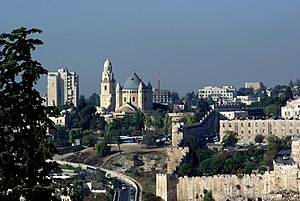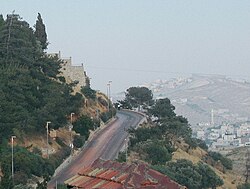Mount Zion
| Mount Zion | |
|---|---|
| הַר צִיוֹן (Har Tsiyyon) جبل صهيون (Jabel Sahyoun) | |
Old City of Jerusalem
| |
| Location | Judean |
Mount Zion (
Etymology
The


Sahyun (
The phrase Har Tzion, lit. "Mount Zion", appears nine times in the
The three different locations

The name Mount Zion referred successively to three locations, as Jerusalemites preserved the time-honoured name, but shifted the location they venerated as the focal point of biblical Jerusalem to the site considered most appropriate in their own time.
Lower Eastern Hill (City of David)
At first, Mount Zion was the name given to the
According to the
Upper Eastern Hill (Temple Mount)
Once the First Temple was erected at the top of the Eastern Hill, the name "Mount Zion" migrated there too.[1]
After the conquest of the Jebusite city, its built-up area expanded northward towards the uppermost part of the same, Eastern Hill. This highest part became the site of Solomon's Temple.
The identification of the pre-Israelite (Jebusite) and Israelite towns on the Eastern Hill is based on the existence of only one perennial water source in the area, the Gihon Spring, and on archaeological excavations revealing sections of the Bronze Age and Iron Age city walls and water systems.[1][9]
The "Mount Zion" mentioned in the later parts of the
Western Hill (today's Mount Zion)

The last shift of the name Mount Zion was to the Western Hill, which is more dominant than the Eastern Hill and seemed to first-century CE Jerusalemites the worthier location for the by-then lost palace of King David. The Western Hill is what today is called Mount Zion.[1]
In the second half of the First Temple period, the city expanded westward and its defensive walls were extended to include the entire Western Hill behind them.
History since the Late Roman period
At the end of the Roman period, a synagogue was built at the entrance of the structure known as David's Tomb, probably based on the belief that David brought the Ark of the Covenant here from Beit Shemesh and Kiryat Ye'arim before the construction of the Temple.[13]
During the
Between 1948 and 1967, when the Old City was under Jordanian rule, Israelis were forbidden access to the Jewish holy places. Mount Zion was a designated no-man's land between Israel and Jordan.[15] Mount Zion was the closest accessible site to the ancient Jewish Temple. Until East Jerusalem was captured by Israel in the Six-Day War, Israelis would climb to the rooftop of David's Tomb to pray.[16] The winding road leading up to Mount Zion is known as Pope's Way (Derekh Ha'apifyor). It was paved in honor of the historic visit to Jerusalem of Pope Paul VI in 1964.[15]
Biblical references
The Tanakh reference to Har Tzion (Mount Tzion) that identifies its location is derived from the Psalm 48 composed by the sons of
In the New Testament, Mount Zion is used metaphorically to refer to the heavenly Jerusalem, God's holy, eternal city. Christians are said to have “ . . . come to Mount Zion and to the city of the living God, the heavenly Jerusalem, to an innumerable company of angels, to the general assembly and church of the firstborn who are registered in heaven” (Hebrews 12:22-23 cf. Revelation 14:1).
Landmarks

Important sites on Mount Zion are
Notable burials in the
Archaeology
In 1874, an Englishman, Henry Maudsley, discovered a large segment of rock scarp and numerous ancient dressed stones on Mount Zion that were believed to be the base of Josephus's First Wall. Several of these stones were used to construct a retaining wall outside the main gate of the Bishop Gobat school (later known as the American Institute of Holy Land Studies and Jerusalem University College).[20]
See also
References
- ^ ISBN 978-0-89870-865-3.
- ^ The Significance of Jerusalem: A Jewish Perspective
- ^ Menashe Harel (1977). This is Jerusalem. Jerusalem: Canaan Publishing. pp. 194–195.
- ^ ISBN 978-0-89900-890-5.
- ^ ISBN 978-0-8308-1783-2.
- ^ ISBN 978-0-8028-3782-0.
- ^ a b Palestine Exploration Fund (1977). Palestine exploration quarterly. Published at the Fund's Office. p. 21.
- ^ The Responsa Project: Version 13, Bar Ilan University, 2005
- ^ Menashe Harel (1977). This is Jerusalem. Jerusalem: Canaan Publishing. p. 193.
- ^ Menashe Harel (1977). This is Jerusalem. Jerusalem: Canaan Publishing. p. 272.
- ^ Flavius Josephus. The Wars of the Jews or History of the Destruction of Jerusalem. Translated by William Whiston. Project Gutenberg. Retrieved 19 February 2016.
The city was built upon two hills, which are opposite to one another, and have a valley to divide them asunder; [...] Of these hills, that which contains the upper city is much higher, and in length more direct. Accordingly, it was called the "Citadel," by king David; [...] Now the Valley of the Cheesemongers, as it was called, and was that which we told you before distinguished the hill of the upper city from that of the lower,... (Book 5, Chapter 4, §1; or V:137)
- ^ The genuine works of Flavius Josephus..., translated by William Whiston, Havercamp edition, New York (1810). See footnote on page 83. (copy&pg=PA83 Mount Zion, p. 83, at Google Books)
- ^ Menashe Harel (1977). This is Jerusalem. Jerusalem: Canaan Publishing. p. 273.
- ^ Mt. Zion Cable Car Archived 2012-08-13 at the Wayback Machine
- ^ a b Bar-Am, Aviva. "On the spot". Jerusalem Post. Retrieved 2007-10-23.[permanent dead link]
- ^ Jerusalem Divided: The Armistice Regime, 1947-1967, Raphael Israeli, Routledge, 2002, p. 6
- ^ Ronald L. Eisenberg, The streets of Jerusalem: who, what, why, Devora Publishing, 2006, p.169
- ^ Menachem Davis, ed., The Book of Psalms, Mesorah Publications, New York, 2001, p.128
- ^ Rubinstein, Danny. "A sign points to the grave". Haaretz.com. Retrieved 2007-10-23.
- ^ Pixner, Bargil (June 1997). Shanks, Hershel (ed.). "Where the Community Lived in Jesus' Time". Biblical Archaeology Review. Biblical Archaeology Society. Archived from the original on 19 January 2015. Retrieved 14 March 2020 – via Jerusalem's Essene Gateway.
External links
![]() Media related to Mount Zion at Wikimedia Commons
Media related to Mount Zion at Wikimedia Commons
